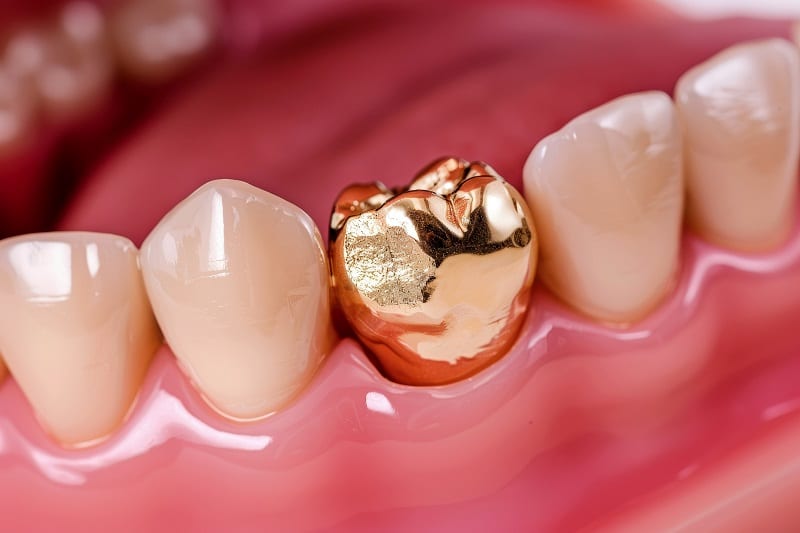Fillings are a key treatment in maintaining healthy teeth and improving your oral health. Fillings are used to fill the small holes left after tooth decay has been cleared. The filling will protect the tooth and prevent further decay. Untreated tooth decay can spread through the tooth, causing significant problems, so having fillings is essential to maintain the health of your teeth. Historically, fillings were made of a metal amalgam, but nowadays dentists often recommend a more natural-looking composite to repair your teeth.
What Material do Dentists Use to Fill Teeth?
Dentists can use an array of different materials. These materials do vary in price, but it is important to understand the benefits of each so that you can choose the best filling for your teeth. Different teeth can require a different type of filling. Back teeth, commonly used for chewing, are less visible, so the final look of the filling may not be as vital. However, a front tooth is very visible, so being able to choose a natural-looking filling, is good to maintain the quality of your smile. Your dental professional will advise on the best solution for your teeth.
Different Types of Materials Used for Fillings
We will take a look at the benefits associated with different types of fillings.
Amalgam
Amalgam is made using a mix of metals, including mercury and a silver alloy. The mercury is safe when combined with the silver alloy. This gives a silver-coloured finish and is commonly used in the back teeth. This filling is hard-wearing and long-lasting, however, it is not suitable for people who are pregnant, breastfeeding, or for children.
Composite Filling
Composite filling is made with powdered glass quartz, silica or other ceramic particles added to a resin base. This is hardened with a special light to make the composite set. A composite filling is a natural colour, which can be matched to your teeth, making it a good choice for a more visible tooth. Composite fillings are not as hard-wearing as amalgam fillings and may need to be replaced over time.
Glass Ionomer
Glass ionomer fillings work by forming a chemical link with the tooth. They are quick and easy to use but are a weaker type of filling. They are commonly used for children, who may need small fillings in their baby teeth.
Gold

Gold is a very hard-wearing and long-lasting metal, so will last for many years. Gold fillings can be used in all types of teeth. However, gold fillings can be more expensive, partly due to the fact that the filling needs to be cast, and then inserted into your cavity, rather than being able to simply fill the hole with a filling material.
Ceramic
Ceramic fillings can be made to match the colour of your tooth, making them a good choice for more visible areas. They are hard-wearing and long-lasting, and are more resistant to staining than composite fillings.
Porcelain
Porcelain inlays can be made to perfectly fit your teeth. They are hard-wearing and can be matched to your natural tooth colour. Porcelain is a good choice for a long-lasting natural natural-looking filling for your tooth.
What is The Safest Tooth Filling Material?
All modern fillings are considered to be safe. Older metal fillings were made with a high concentration of mercury, which had the potential to release mercury vapour, which could be harmful. Modern amalgams are more stable and are currently still being used as an affordable and practical filling material. If you have very old fillings, you can have them removed but always seek advice from your dental professional. Modern dental fillings such as composite have been designed to be a completely safe solution for dental filling. There are proposals to ban the use of mercury in fillings, however, this will cause issues within the supply chain and could result in people not being able to receive fillings, which could lead to potentially more health risks. Currently, amalgam fillings are not used in children, and people who are pregnant or breastfeeding.
What is The Cheapest Tooth Filling?
Amalgam fillings are the cheapest filling, giving a long-lasting filling for a reasonable cost. If you want a more natural-looking filling then a composite filling would be a good choice. It is important to remember that your oral health is extremely crucial, and it is wise to ask your dentist for their advice, rather than make decisions that could affect your long-term health purely for financial reasons. Generally, the more expensive fillings last for longer, so while they may cost more upfront, they may be a better investment over time.
Which Type of Tooth Filling is Best?
Different fillings are suitable for different teeth, so your dental professional will always advise on the best filling for you. A child needing a small cavity filled in a baby tooth will need an entirely different filling material than an adult needing a molar filled. Front teeth, which are visible, will benefit from a natural-looking filling, whilst back teeth don’t require the same aesthetically pleasing finish. These considerations will all need to be balanced out when choosing the best filling for your teeth.
Improve Your Oral Health With High-quality Dental Fillings
In an ideal world, we would never have cavities, but sugar, genetics, and other factors all contribute towards cavities. Remember to look after your teeth, with regular brushing and flossing, to minimise the chance of developing cavities. By visiting your dentist and dental hygienist regularly you will be more likely to catch cavities before they get too large, and the smaller the cavity, the quicker and easier it is to fill. If your dentist does find a cavity, we will discuss the treatment with you, and advise on the best filling for your teeth. Make sure you have regular check-ups to help maintain your beautiful smile. Our experienced and professional team are here to help, simply call the team at Boutique Dental 23 today on 01942 727465

